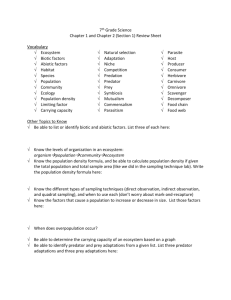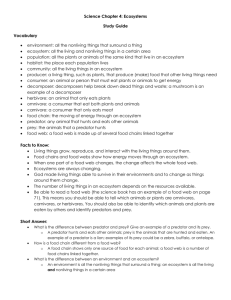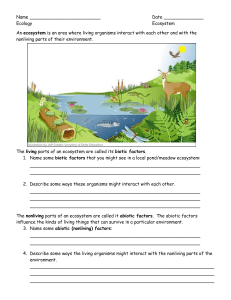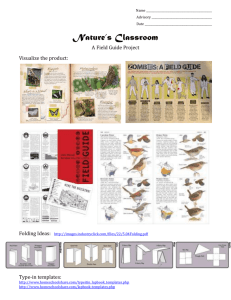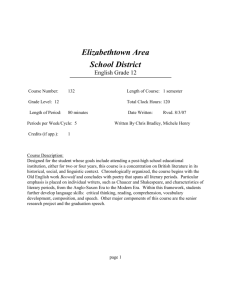Objective 1 Test Bank
advertisement
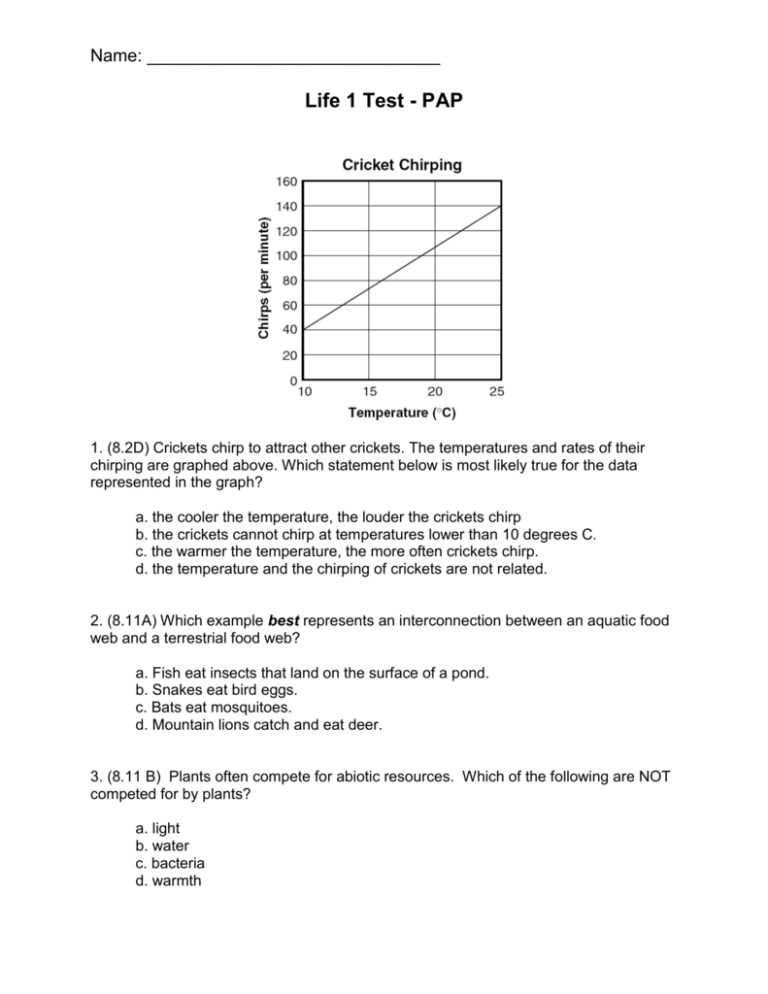
Name: ______________________________ Life 1 Test - PAP 1. (8.2D) Crickets chirp to attract other crickets. The temperatures and rates of their chirping are graphed above. Which statement below is most likely true for the data represented in the graph? a. the cooler the temperature, the louder the crickets chirp b. the crickets cannot chirp at temperatures lower than 10 degrees C. c. the warmer the temperature, the more often crickets chirp. d. the temperature and the chirping of crickets are not related. 2. (8.11A) Which example best represents an interconnection between an aquatic food web and a terrestrial food web? a. Fish eat insects that land on the surface of a pond. b. Snakes eat bird eggs. c. Bats eat mosquitoes. d. Mountain lions catch and eat deer. 3. (8.11 B) Plants often compete for abiotic resources. Which of the following are NOT competed for by plants? a. light b. water c. bacteria d. warmth 4. (8.2D) Scientists have spent many years studying the peppered moth, which is a species that has adapted its color from light to dark in reaction to environmental pollution. Which of the following line graphs represents the data from the table? a. b. c. d. 5. (8.11 A) Which of the following is correct about the relationship between predators and their prey population? a. if the prey population decreases, the predator population increases b. If there is an increase in predator population, the prey may not be able to reproduce quickly enough to support the predator population c. If the prey population increases, the predator population will decrease d. Abiotic factors have no affect on predator/prey relationships 6. (8.11 B) The picture above shows a snake and a scorpion in a desert environment. The snake and scorpion would most likely compete fora. air b. light c. space d. water 7. (8.11B) Which of these species would be most in danger of becoming extinct if one of their food sources became unavailable? a. Brown Bear b. Panda c. Polar Bear d. Black Bear 8. (8.11 B) A food web for an aquatic ecosystem is shown above. In this ecosystem, which organisms are in direct competition for minnows? a. Bass and algae b. Frogs and insects c. Frogs and turtles d. Herons and insects 9. (8.2B) Which of these experimental designs would best test this hypothesis? a. b. c. d. 10. (8.2C) The line graph shows the heights of plants grown in fertilized and unfertilized soil. Based on this information, what will MOST likely occur on day six? a. b. c. d. Neither plant should increase by 1 cm in height Plant A should increase about 1 cm in height Plant B should increase about 1 cm in height Plant A should increase about 2 cm in height 11. (8.11 B) According to the food web to the right, which animals compete for food? a. owl-squirrel b. mouse-frog c. mouse-squirrel d. fox-squirrel 12. (8.11A) All energy transformations in an ecosystem begin with – a. b. c. d. a scavenger the sun a decomposer a herbivore Use the food web below to answer questions #13-14. 13. (8.11A) Look at the food web shown above. If all the snakes were killed, what is the first organism that will be affected in the balance of organisms in this ecosystem? a. Increased populations of mice and frogs b. An increased population of crickets c. Decreased populations of plants and seeds d. A decreased population of rabbits 14. (8.11 A) Look at the food web shown above. If all the crickets are removed from this ecosystem, the population that will most likely decrease first is — a. Plants b. Frogs c. Mice d. Snakes Use the food web below to answer questions #15 - 17. 15. (8.11A) All of these terms describe the hawk except – a. b. c. d. producer carnivore predator consumer 16. (8.11B) Which 2 organisms are in competition for the same food source? a. b. c. d. coyote & rabbit hawk & rabbit hawk & mouse coyote & hawk 17. (8.11A) In the food web above, which of the following pairs is not a predator/prey relationship? a. b. c. d. Black-tailed Rabbit, Coyote Deer Mouse, Red-Tailed Hawk Deer Mouse, Coyote Black-tailed Rabbit, Deer Mouse 18. (8.11A) In the food web above, which of the following organisms is both a primary and secondary consumer? a. b. c. d. 19. (8.11A) Which type of organism is not depicted in the food web above? a. b. c. d. Decomposer Producer Herbivore Omnivore 20. (8.5D) The elements that make up the compound glucose are a. b. c. d. carbon dioxide and hydrogen carbon dioxide and water carbon, hydrogen and oxygen carbon, hydrogen, and sunlight energy 21. (8.11C) In the food web above, which organism’s food supply would be least affected by a spray that kills large numbers of aphids? a. b. c. d. Tomatoes Lacewings Lady beetles Spiders 22. When a goat eats grass, what form of energy passes directly from the grass to the goat? a. b. c. d. Heat Electrical Light Chemical 23. (8.11A) The fungi shown in the picture are decomposers. Decomposers are an important part of an ecosystem because they a. b. c. d. produce oxygen provide food for carnivores break down dead organisms convert sunlight into food energy 24. (8.11B) One bird species that feeds on large seeds nests in the same tree as a bird that feeds on small seeds. How are the birds able to coexist? a. b. c. d. they occupy different ecosystems they occupy different niches they occupy different communities they occupy different habitats Use the following food web to answer questions #24 – 26. 25. (8.11C) In the food web above, what would most likely happen to the future population of hawks if the insects decreased? a. b. c. d. increase decrease stay the same cannot be determined 26. (8.11C) In the food web above, what population of organism would be affected the greatest if the decomposers were eliminated? a. b. c. d. producers primary consumers secondary consumers tertiary consumers 27. (8.11A) Which abiotic factor could change without disrupting this ecosystem? a. b. c. d. temperature amount of sunlight amount of soil all would disrupt the ecosystem 28. (8.11A) If elements are to be recycled in nature, which organisms must be present? a. b. c. d. predators herbivores parasites decomposers 29. (8.11C) Which statement describes why pesticides are said to “move up the food chain”? a. pesticides have a greater effect on larger animals than on insects b. top predators often accumulate the pesticides contained in the bodies of their prey c. birds and predatory mammals are not affected by pesticides d. pesticides kill insects and other target pests before they can absorb the poison 30. (8.2E) Harvested almost to extinction, a sea mammal received “endangered species” protection several years ago. Which graph most accurately represents its history and the desired outcome from protection?


